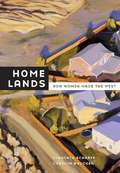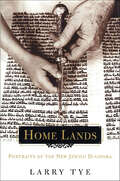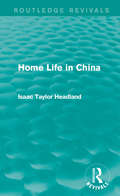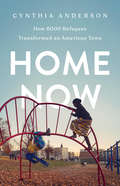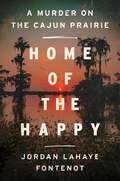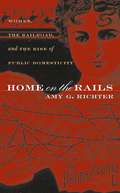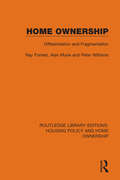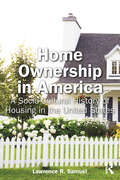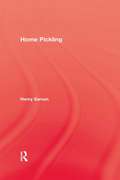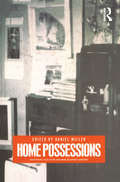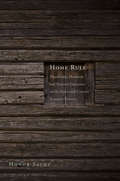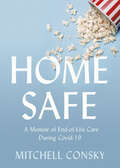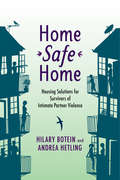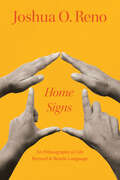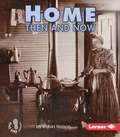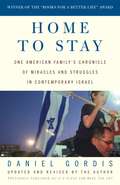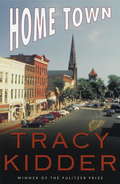- Table View
- List View
Home Lands: How Women Made the West
by Virginia Scharff Carolyn Brucken.Home Lands: How Women Made the West upends the view to remember the West as a place of homes and habitations brought into being by the women who lived there.
Home Lands: Portraits of the New Jewish Diaspora
by Larry TyeThe idea for this book came to Larry Tye as he traveled overseas as a reporter for the Boston Globe. In each city he visited he was intrigued by a reawakening of practice and spirit of the long repressed Jewish community. And the more communities he saw close-up, the clearer it became to him that the Jewish world was being reshaped and revitalized in ways that were not reflected in what he was reading about the disappearing diaspora and the vanishing Jews of America.The result is Home Lands, an narrative that tells the story of the new Jewish diaspora. Tye picked seven Jewish communities from Boston to Buenos Aires and Dusseldorf to Dnepropetrovsk deep in the Ukraine, and in each he zeroes in on a single family or congregation whose tale reflects the wider community's history and current situation. He met each community's leaders, talked with their scores of young people and old, and went with them to High Holiday services and Sabbath celebrations.The first impression that emerges from his travels is each city's uniqueness. Far more striking than the differences, however, is the unity. Jews all over the world still have enough customs and rituals in common for outsiders to see them as part of the same people, and for them to define themselves that way. It is that new comfort level, that sense of finally feel comfortable in the lands where they are living, that is at the heart of this engrossing book. Readers' eyes will be opened to how Germany, just a generation after the genocide, has the world's fastest-growing Jewish population; how the Jews of Buenos Aires have carved a place for themselves in a land that also gave refuge to Nazi henchmen like Adolph Eichman, and how Ireland is home to a tight-knit Jewish community that, remarkably, has produced Jewish Lord Mayors in Belfast, Cork and, twice from the same family, in Dublin. In Boston, Tye tells the story of his own family, whose roots run deep in the city's Jewish community.Home Lands is a book that is deeply personal even as it sheds light on the larger Jewish experience.
Home Life in China (Routledge Revivals)
by Isaac Taylor HeadlandOriginally published in 1914, this text describes L.T. Headland and his wife’s experience in China in the early twentieth century. With a focus on home life this study explores issues such as children, marriage and education as well as food, religion and concubinage as well as presenting anecdotes and personal stories from the families Headland interacted with. This title will be of interest to students of Asian Studies and Anthropology.
Home Now: How 6000 Refugees Transformed an American Town
by Cynthia AndersonA moving chronicle of who belongs in America.Like so many American factory towns, Lewiston, Maine, thrived until its mill jobs disappeared and the young began leaving. But then the story unexpectedly veered: over the course of fifteen years, the city became home to thousands of African immigrants and, along the way, turned into one of the most Muslim towns in the US. Now about 6,000 of Lewiston's 36,000 inhabitants are refugees and asylum seekers, many of them Somali. Cynthia Anderson tells the story of this fractious yet resilient city near where she grew up, offering the unfolding drama of a community's reinvention--and humanizing some of the defining political issues in America today. In Lewiston, progress is real but precarious. Anderson takes the reader deep into the lives of both immigrants and lifelong Mainers: a single Muslim mom, an anti-Islamist activist, a Congolese asylum seeker, a Somali community leader. Their lives unfold in these pages as anti-immigrant sentiment rises across the US and national realities collide with those in Lewiston. Home Now gives a poignant account of America's evolving relationship with religion and race, and makes a sensitive yet powerful case for embracing change.
Home of the Happy: A Murder on the Cajun Prairie
by Jordan LaHaye Fontenot"Riveting and atmospheric, Home of the Happy is also a heartfelt grappling with a trauma in the author’s family and her attempts to unravel its secrets once and for all. LaHaye Fontenot’s writing is urgent, fueled not just by a desire for justice but by love for her ancestors and the Cajun community of south Louisiana. A must-read for true crime and mystery fans."— Ana Reyes, New York Times bestselling author of The House in the PinesOn January 16, 1983, Aubrey LaHaye’s body was found floating in the Bayou Nezpique. His kidnapping ten days before sparked “the biggest manhunt in the history of Evangeline Parish.” But his descendants would hear the story as lore, in whispers of the dreadful day the FBI landed a helicopter in the family’s front lawn and set out on horseback to search for the seventy-year-old banker.Decades later, Aubrey’s great-granddaughter Jordan LaHaye Fontenot asked her father, the parish urologist, to tell the full story. He revealed that to this day, every few months, one of his patients will bring up his grandfather’s murder, and the man accused of killing him, John Brady Balfa, who remains at the Louisiana State Penitentiary at Angola serving a life sentence. They’ll say, in so many words: “Dr. Marcel, I really don’t think that Balfa boy killed your granddaddy.” For readers of Maggie Nelson’s The Red Parts and Emma Copley Eisenberg's The Third Rainbow Girl, Home of the Happy unravels the layers of suffering borne of this brutal crime—and investigates the mysteries that linger beneath generations of silence. Is it possible that an innocent man languishes in prison, still, wrongly convicted of murdering the author’s great-grandfather?
Home on the Rails
by Amy G. RichterRecognizing the railroad's importance as both symbol and experience in Victorian America, Amy G. Richter follows women travelers onto trains and considers the consequences of their presence there.For a time, Richter argues, nineteenth-century Americans imagined the public realm as a chaotic and dangerous place full of potential, where various groups came together, collided, and influenced one another, for better or worse. The example of the American railroad reveals how, by the beginning of the twentieth century, this image was replaced by one of a domesticated public realm--a public space in which both women and men increasingly strove to make themselves "at home."Through efforts that ranged from the homey touches of railroad car decor to advertising images celebrating female travelers and legal cases sanctioning gender-segregated spaces, travelers and railroad companies transformed the railroad from a place of risk and almost unlimited social mixing into one in which white men and women alleviated the stress of unpleasant social contact. Making themselves "at home" aboard the trains, white men and women domesticated the railroad for themselves and paved the way for a racially segregated and class-stratified public space that freed women from the home yet still preserved the railroad as a masculine domain.
Home Ownership: Differentiation and Fragmentation
by Ray Forrest Alan Murie Peter WilliamsOriginally published in 1990 and drawing on extensive research, this book provides an evaluation of the impact of the growth of home ownership in the UK, and of the claims and counter-claims made for its social significance. The book examines critically the evidence for and against the proposition that mass home ownership is contributing towards a more equal society. Wide-ranging in its coverage, the book discusses the changing nature and role of home ownership, wealth accumulation and housing, the relationship between social class and housing tenure, and policy development.
Home Ownership in America: A Socio-Cultural History of Housing in the United States
by Lawrence SamuelA wide-ranging cultural history centered around the concepts of real estate, the family home, and the American dream, and how they evolved over the years, Home Ownership in America: A Socio-Cultural History of Housing in the United States traces narratives around home ownership from the 1920s to today.As a product of the emergence of a large middle class during the Roaring Twenties, the modern concept of home ownership continued through the shaky Great Depression years, holding pattern of World War II, and glory days of the postwar era, when home ownership became a reality for much of the White middle class. While the late 1960s and 1970s were difficult years for home ownership as the postwar economic engine ran out of steam, a renaissance took place in the 1980s and 1990s due to tens of millions of baby boomers wanting to nest. Although there have been a few bumps in the road over the last couple of decades, home ownership, or at least the pursuit of it, is once again booming, making the subject as relevant as ever.With the single-family home central to the American idea and experience, this book touches on a host of issues related to our social divisions of race, gender, and class. Home Ownership in America is a truly interdisciplinary study, crossing over into a wide variety of subjects including sociology, family, urban history/planning, suburban studies, the built environment, public policy, business, finance, economics, politics, architecture, design, technology, and popular and consumer culture.
Home Pickling
by Henry SarsonFirst published in 2005. Cooks eager to rediscover the lost culinary art of pickling will be weIl served by this fascinating and informative text, written by the founder of the best-known vinegar and pickling company in the United Kingdom. Beginning with an explanation of the history of pickling, principles and advantages, the book goes on to give detailed instructions on the preservation of artichokes, beans, beetroot, cabbage, shallots, tomatoes, peaches, cherries, a wide variety of chutneys and ketchups, meats and many other foods. Instructions are also given for mixing spices and determining correct levels of acidity and brine.
Home Possessions: Material Culture Behind Closed Doors
by Daniel MillerAlthough so much of the life we care about takes place at home, this private space often remains behind closed doors and is notoriously difficult for researchers to infiltrate. We may think it is just up to us to decorate, transform and construct our homes, but in this book we discover a new form of ‘estate agency', the active participation of the home and its material culture in the construction of our lives. What do the possessions people choose to take with them when moving say about who they are, and should we emphasize the mobility of a move or the stability of what movers take with them? How is the home an active partner in developing relationships? Why are our homes sometimes haunted by 'ghosts'?. This intriguing book is a rare behind-the-scenes exposé of the domestic sphere across a range of cultures. Examples come from working class housewives in Norway, a tribal society in Taiwan, a museum in London, tenants in Canada and students from Greece, to produce a genuinely comparative perspective based in every case on sustained fieldwork. So Japan, long thought to be a nation that idealizes uncluttered simplicity, is shown behind closed doors to harbour illicit pockets of disorganization, while the warmth inside Romanian apartments is used to expel the presence of the state. Representing a vital development in the study of material culture, this book clearly shows that we may think we possess our homes, but our homes are more likely to possess us.
Home Rule
by Honor SachsOn America's western frontier, myths of prosperity concealed the brutal conditions endured by women, slaves, orphans, and the poor. As poverty and unrest took root in eighteenth-century Kentucky, western lawmakers championed ideas about whiteness, manhood, and patriarchal authority to help stabilize a politically fractious frontier. Honor Sachs combines rigorous scholarship with an engaging narrative to examine how conditions in Kentucky facilitated the expansion of rights for white men in ways that would become a model for citizenship in the country as a whole. Endorsed by many prominent western historians, this groundbreaking work is a major contribution to frontier scholarship.
Home Rule: National Sovereignty and the Separation of Natives and Migrants
by Nandita SharmaIn Home Rule Nandita Sharma traces the historical formation and political separation of Natives and Migrants from the nineteenth century to the present to theorize the portrayal of Migrants as “colonial invaders.” The imperial-state category of Native, initially a mark of colonized status, has been revitalized in what Sharma terms the Postcolonial New World Order of nation-states. Under postcolonial rule, claims to autochthony—being the Native “people of a place”—are mobilized to define true national belonging. Consequently, Migrants—the quintessential “people out of place”—increasingly face exclusion, expulsion, or even extermination. This turn to autochthony has led to a hardening of nationalism(s). Criteria for political membership have shrunk, immigration controls have intensified, all while practices of expropriation and exploitation have expanded. Such politics exemplify the postcolonial politics of national sovereignty, a politics that Sharma sees as containing our dreams of decolonization. Home Rule rejects nationalisms and calls for the dissolution of the ruling categories of Native and Migrant so we can build a common, worldly place where our fundamental liberty to stay and move is realized.
Home Safe: A Memoir of End-of-Life Care During Covid-19
by Mitchell ConskyDuring a pandemic lockdown full of pyjama dance parties, life talks, and final goodbyes, a family helps a father die with dignity.In April 2020, journalist Mitchell Consky received bad news: his father was diagnosed with a rare and terminal cancer, with less than two months to live. Suddenly, he and his extended family — many of them healthcare workers — were tasked with reconciling the social distancing required by the Covid-19 pandemic with a family-based approach to end-of-life care. The result was a home hospice during the first lockdown. Suspended within the chaos of medication and treatments were dance parties, episodes of Tiger King, and his father’s many deadpan jokes. Leaning into his journalistic intuitions, Mitchell interviewed his father daily, making audio recordings of final talks, emotional goodbyes, and the unexpected laughter that filled his father’s final days. Serving as a catalyst for fatherly affection, these interviews became an opportunity for emotional confession during the slowed-down time of a shuttered world, and reflect how far a family went in making a dying loved one feel safe at home.
Home Safe Home: Housing Solutions for Survivors of Intimate Partner Violence
by Andrea Hetling Carol Corden Hilary BoteinHousing matters for everyone, as it provides shelter, security, privacy, and stability. For survivors of intimate partner violence (IPV), housing takes on an additional meaning; it is the key to establishing a new life, free from abuse. IPV survivors often face such inadequate housing options, however, that they must make excruciating choices between cycling through temporary shelters, becoming homeless, or returning to their abusers. Home Safe Home offers a multifaceted analysis that accounts for both IPV survivors' needs and the practical challenges involved in providing them with adequate permanent housing. Incorporating the varied perspectives of the numerous housing providers, activists, policymakers, and researchers who have a stake in these issues, the book also lets IPV survivors have their say, expressing their views on what housing and services can best meet their short and long-term goals. Researchers Hilary Botein and Andrea Hetling not only examine the federal and state policies and funding programs determining housing for IPV survivors, but also provide detailed case studies that put a human face on these policy issues. As it traces how housing options and support mechanisms for IPV survivors have evolved over time, Home Safe Home also offers innovative suggestions for how policymakers and advocates might work together to better meet the needs of this vulnerable population.
Home Signs: An Ethnography of Life beyond and beside Language
by Joshua O. RenoAn intimate account of an anthropologist’s relationship with his non-verbal son and how it has shaped and transformed his understanding of closeness and communication. Home Signs grew out of the anthropologist Joshua Reno’s experience of caring for and trying to communicate with his teenage son, Charlie, who cannot speak. To manage interactions with others, Charlie uses what are known as “home signs,” gestures developed to meet his need for expression, ranging from the wiggle of a finger to a subtle sideways glance. Though he is nonverbal, he is far from silent: in fact, he is in constant communication with others. In this intimate reflection on language, disability, and togetherness, the author invites us into his and Charlie’s shared world. Combining portraits of family life and interviews with other caregivers, Reno upends several assumptions, especially the idea that people who seem not to be able to speak for themselves need others to speak on their behalf. With its broad exploration of nonverbal communication in both human and nonhuman contexts, Home Signs challenges us to think harder about what it means to lead a “normal” life and to connect with another person.
Home States and Homeland Politics: Interactions between the Turkish State and its Emigrants in France and the United States (Studies in Migration and Diaspora)
by Damla B. AkselThis book draws on the literatures of transnationalism and diaspora studies to explore the ways in which the policies of emigrant-sending countries have an influence on how emigrants politically engage on issues related to their homelands. Drawing on over one hundred interviews with policy makers, diplomats, bureaucrats, members of civil society and academics in Turkey, France and the United States, it offers a comparison of the engagement of Turkish migrants with political issues in Turkey in periods both before and after home state policies have been constructed with a view to engaging emigrants. As such, it will appeal to scholars of sociology and politics with interests in diaspora and the engagement of migrants with political issues in their countries of origin.
The Home Stretch: Why It's Time to Come Clean About Who Does the Dishes
by Sally HowardForty years of feminism and still women do the majority of the housework. Why?In fact, while women are making slow but steady gains on gender disparities in the workplace, at home the gap is widening - in the UK, the average heterosexual British woman puts in 12 more days of household labour per year than her male companion, while young American men are now twice as likely as their fathers to think a woman's place is in the home. And when 'having it all' so often means hiring a nanny or cleaner, is it something to aspire to? Sally Howard joins up with a cohort of feminist separatists, undertakes a day's shift with her Lithuanian cleaner, lives in a futuristic model home designed to anticipate our needs and meets latte papas and one-percent parents in this lively examination which combines history and fieldwork with her personal story. The Home Stretch is a fascinating investigation into how we got here and what the future could look like for feminism's final frontier: the domestic labour gap.
Home Territories: Media, Mobility and Identity (Comedia)
by David MorleyHome Territories examines how traditional ideas of home, homeland and nation have been destabilised both by new patterns of migration and by new communication technologies which routinely transgress the symbolic boundaries around both the private household and the nation state. David Morley analyses the varieties of exile, diaspora, displacement, connectedness, mobility experienced by members of social groups, and relates the micro structures of the home, the family and the domestic realm, to contemporary debates about the nation, community and cultural identities. He explores issues such as the role of gender in the construction of domesticity, and the conflation of ideas of maternity and home, and engages with recent debates about the 'territorialisation of culture'.
Home Theater Hacks
by Brett MclaughlinIt might be the long lines at the theater, the $4.00 for a small bag of popcorn, or the cutting-edge technology that's now so readily available to the home market. Whatever the reason, the home theater market today is booming like the soundtrack to Star Wars! Want proof? A Google search for home theater reveals over three million results. Yikes! It's simply undeniable: More and more people prefer watching their favorite movies, television shows, and videos from the comfort of their own sofas and couches. What's also undeniable is the inexperience of most people who choose to install or upgrade their home theaters. Until now, the knowledge, technique, and experiences of those who've encountered similar conditions to yours could only be accessed through laborious web searches, stacks of magazines, and water cooler conversations. Home Theater Hacks from O'Reilly is the perfect remedy for this group. A smart collection of insider tips and tricks, Home Theater Hacks covers home theater installation from start to finish, purchase to experience. Just imagine: no frustrating trial-and-error process and better yet, no expensive appointments with installation experts. Home Theater Hacks prevents both by imparting down-and-dirty technique not found anywhere else. The book begins with a quick glossary of terms so you can speak the lingo when you go shopping, and then dives right into hush-hush, insider tricks. It's all covered where to find the right audio and video components, how to deal with speakers and wiring, understanding cable connectivity, mastering remote controls, how to fully grasp TiVo, and so much more. And to top it off, each of these insider tips is presented in a concise yet delightfully entertaining style. Bringing the Jurassic Park dinosaurs into your living room has never been so easy! A seasoned veteran with numerous O'Reilly titles under his belt, author Brett McLaughlin leaves no stone unturned in helping you customize your home theater experience to your own personal environment.
Home Then and Now (First Step Nonfiction -- Then And Now Ser.)
by Robin NelsonPresents a brief look at how homes in the United States have changed over the years.
Home To Stay: One American Family's Chronicle of Miracles and Struggles in Contemporary Israel
by Daniel GordisIn the summer of 1998, Daniel Gordis and his family moved to Israel from Los Angeles. They planned to be there for a year, but a few months into their stay, Gordis and his wife decided to remain in Jerusalem permanently, confident that their children would be among the first generation of Israelis to grow up in peace. Immediately after arriving in Israel, Daniel had started sending out e-mails about his life to friends and family abroad. These missives—passionate, thoughtful, beautifully written, and informative—began reaching a much broader readership than he’d ever envisioned, eventually being excerpted inThe New York Times Magazineto much acclaim. An edited and finely crafted collection of his original e-mails,Home to Stayis a first-person, immediate account of Israel’s post-Oslo meltdown that cuts through the rhetoric and stridency of most dispatches from that country or from the international media. This is must reading for anyone who wants to get a firsthand, personal view of what it’s like for a family on the front lines of war.
Home Town
by Tracy KidderIn this splendid book, one of America's masters of nonfiction takes us home--into Hometown, U.S.A., the town of Northampton, Massachusetts, and into the extraordinary, and the ordinary, lives that people live there. <P><P>As Tracy Kidder reveals how, beneath its amiable surface, a small town is a place of startling complexity, he also explores what it takes to make a modern small city a success story. <P>Weaving together compelling stories of individual lives, delving into a rich and varied past, moving among all the levels of Northampton's social hierarchy, Kidder reveals the sheer abundance of life contained within a town's narrow boundaries. <P>Does the kind of small town that many Americans came from, and long for, still exist? <P> Kidder says yes, although not quite in the form we may imagine. <P>A book about civilization in microcosm, Home Town makes us marvel afresh at the wonder of individuality, creativity, and civic order--how a disparate group of individuals can find common cause and a code of values that transforms a place into a home. And this book makes you feel you live there.
Home Truths: Gender, Domestic Objects and Everyday Life
by Sarah PinkHomes are powerfully defined by smells, sounds, textures and objects, all of which reflect how people live their everyday lives. From spray-painting the toilet wall to relaxing in the bath, the products we use speak volumes about who we are, how we relate to others and who we want to be. Based on extensive fieldwork, this fascinating book explores the intimate, material and sensory spaces of the home to uncover how gender roles are performed within our personal, private worlds. Pink shows how everyday items ranging from perfumes to soap powder imprint and reinforce daily experiences and a sense of identity. How has the home been affected by the fact that more and more women now go to work and increasingly more men spend time engaged in domestic tasks? How do more traditional family-centred homes compare with those belonging to diverse family forms and people living alone? What does a study of domestic gender tell us about how change occurs? Answering these questions and many more, Pink combines the most recent approaches in gender studies and material culture to show how everyday activities can be deeply revealing of gender roles in the 21st century.
Home Truths About Domestic Violence: Feminist Influences on Policy and Practice - A Reader
by Jalna Hanmer Catherine ItzinWhile men's violence to women is an everyday culturally supported activity, this reader demonstrates: that men's violence can be curtailed and that women and children can be assisted effectively; that state policies and provision can be improved; and that women can actively participate in the resolution of their difficulties. Bringing together new work and key papers Home Truths About Domestic Violence provides a comprehensive overview and up-to-date account of the progress so far, and identifies what still needs to be done. Areas covered include: * womens experience of violence * childrens experience of violence * personal experiences of the justice system * state policies on violence in the US and UK * educational programmes and initiatives. This substantial Reader makes a significant contribution to the understanding of domestic violence from both a policy and a practice perspective. Together with its companion volume Home Truths About Child Sexual Abuse it provides an in-depth resource for a wide range of teachers, students and professionals, highlighting the diverse and complex dimensions of the problem of domestic violence.
Home, Uprooted: Oral Histories of India's Partition
by Devika ChawlaThe Indian Independence Act of 1947 granted India freedom from British rule, signaling the formal end of the British Raj in the subcontinent. This freedom, though, came at a price: partition, the division of the country into India and Pakistan, and the communal riots that followed. These riots resulted in the deaths of an estimated 1 million Hindus and Muslims and the displacement of about 20 million persons on both sides of the border. This watershed socioeconomic–geopolitical moment cast an enduring shadow on India’s relationship with neighboring Pakistan. Presenting a perspective of the middle-class refugees who were forced from their homes, jobs, and lives with the withdrawal of British rule in India, Home, Uprooted delves into the lives of forty-five Partition refugees and their descendants to show how this epochal event continues to shape their lives.Exploring the oral histories of three generations of refugees from India’s Partition—ten Hindu and Sikh families in Delhi, Home, Uprooted melds oral histories with a fresh perspective on current literature to unravel the emergent conceptual nexus of home, travel, and identity in the stories of the participants. Author Devika Chawla argues that the ways in which her participants imagine, recollect, memorialize, or “abandon” home in their everyday narratives give us unique insights into how refugee identities are constituted. These stories reveal how migrations are enacted and what home—in its sense, absence, and presence—can mean for displaced populations.Written in an accessible and experimental style that blends biography, autobiography, essay, and performative writing, Home, Uprooted folds in field narratives with Chawla’s own family history, which was also shaped by the Partition event and her self-propelled migration to North America. In contemplating and living their stories of home, she attempts to show how her own ancestral legacies of Partition displacement bear relief.Home—how we experience it and what it says about the “selves” we come to occupy—is a crucial question of our contemporary moment. Home, Uprooted delivers a unique and poignant perspective on this timely question. This compilation of stories offers an iteration of how diasporic migrations might be enacted and what“home” means to displaced populations.
